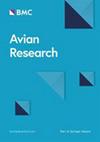亲代表型和繁殖性能:对西方古北山雀和捕蝇鸟的非实验研究综述
IF 1.7
2区 生物学
Q1 ORNITHOLOGY
引用次数: 0
摘要
许多假设预测表型相关的育种性状和繁殖成功之间的关联。在二次腔巢雀形目鸟类中,研究最多的是,多达90多种亲代特征与至少一种繁殖表现的实地测量相关联。然而,在研究种群中,不同的亲代性状,如窝卵大小、首卵日期、卵大小、巢结构、羽毛颜色、成虫形态或鸣叫表现,在雌性和/或雄性繁殖者之间往往呈弱相关。此外,这些研究中的许多都是在离合器大小(IOH)的“个体优化假设”的理论框架之外进行的。IOH预测:(i)相比于较少的卵窝,较大的卵窝的雌鸟在孵化和羽化时会有更多的后代;(ii)窝的大小,根据父母抚养雏鸟的能力进行适应性调整,应该总是最大化产蛋雏鸟的百分比,这样窝的大小的变化就与繁殖成功的变化脱节了。在本文中,我们首次详细回顾了IOH对亲本性状的影响,而不是对窝数的影响。我们回顾了188项非实验研究和1074项统计结果,研究了亲代性状如何影响西部古北大山雀(Parus major)、蓝山雀(Cyanistes spp.)和捕蝇鸟(Ficedula spp.)的繁殖成功。在研究种群中,孵化和羽翼发育阶段的雏鸟数量差异有三分之一是由卵窝大小造成的。然而,大多数亲代特征与雏鸟或雏鸟的数量相关性很弱,可能是因为它们与窝的大小无关。总体而言,亲本性状与每枚蛋的孵化率和雏鸟比例相关性较差。我们讨论了为什么与表型相关的育种性状的种内变异往往与育种成功的个体间差异脱节,并强调了鸟类育种生物学中尚未充分开发的研究问题的重要性。本文章由计算机程序翻译,如有差异,请以英文原文为准。
Parental phenotypes and breeding performance: a review of non-experimental investigation in well-studied Western palearctic tits and flycatchers
Numerous hypotheses predict associations between phenotype-associated breeder traits and reproductive success. In secondary cavity-nesting passerine birds, which have been investigated most, up to more than 90 parental characteristics have been linked to at least one field measure of breeding performance. However, within study populations, different parental traits, such as clutch size, first-egg date, egg size, nest architecture, plumage colour, adult morphometry, or song performance, are often weakly correlated across female and/or male breeders. Furthermore, many of these studies have been conducted outside the theoretical framework of the ‘Individual Optimisation Hypothesis’ of clutch size (IOH). IOH predicts that: (i) females with larger clutches will have larger broods at hatching and fledging compared to those with smaller clutches; and (ii) clutch size, which is adaptively adjusted to the parents' ability to rear nestlings, should always maximize the percentage of eggs producing fledglings so that variation in clutch size becomes disconnected from variation in breeding success. In this paper, we present the first detailed review of implications of IOH for parental characters other than clutch size. Our review covered 188 non-experimental studies and 1074 statistical results that examined how parental traits influence breeding success in Western Palearctic Great Tits (Parus major), Blue Tits (Cyanistes spp.), and flycatchers (Ficedula spp.). Clutch size explained one third of the variation in brood size at hatching and fledging within study populations. However, most parental characteristics associated weakly with the number of hatchlings or fledglings, likely because they did not correlate with clutch size. Overall, parental traits were poorly correlated with the proportion of hatchlings and fledglings per egg. We discuss why intraspecific variation in phenotype-associated breeder traits is often disconnected from interindividual differences in breeding success, and highlight the importance of underexplored research problems in avian breeding biology.
求助全文
通过发布文献求助,成功后即可免费获取论文全文。
去求助
来源期刊

Avian Research
ORNITHOLOGY-
CiteScore
2.90
自引率
16.70%
发文量
456
审稿时长
46 days
期刊介绍:
Avian Research is an open access, peer-reviewed journal publishing high quality research and review articles on all aspects of ornithology from all over the world. It aims to report the latest and most significant progress in ornithology and to encourage exchange of ideas among international ornithologists. As an open access journal, Avian Research provides a unique opportunity to publish high quality contents that will be internationally accessible to any reader at no cost.
 求助内容:
求助内容: 应助结果提醒方式:
应助结果提醒方式:


